LEAP (2013-2017): A Project History, Part I
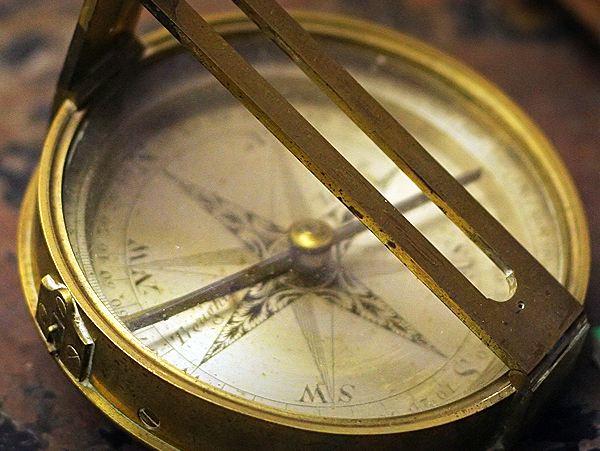
Cite page (MLA): Wisnicki, Adrian S. "LEAP (2013-2017): A Project History, Part I." Megan Ward and Michael B. Toth, eds. Livingstone Online. Adrian S. Wisnicki and Megan Ward, dirs. University of Maryland Libraries, 2016. Web. http://livingstoneonline.org/uuid/node/da31bc5d-a889-49c7-8a85-2c9fc373af4d.
This essay sets out the first part of a history of LEAP: The Livingstone Online Enrichment and Access Project, the NEH-funded initiative that resulted in the development of the present Livingstone Online site and our critical edition of Livingstone's Final Manuscripts (1865-73). The essay combines text, images, and access to downloadable project documents to provide an intimate, behind-the-scenes look into project. The second part of the history can be read here.
- Introduction
- Prelude to a Grant
- LEAP: The Livingstone Online Enrichment and Access Project
- Project Launch
- LA Kickoff
- UK Kickoff
- Digitizing All Those Livingstone Manuscripts
- Data, Data Everywhere
- Transcriptions Old and New, and to One Standard
- The New, Improved, and Expanded Core Digital Collection
- Imagining the New Livingstone Online
- (Re)defining Livingstone Online's Vision
- Getting the Word Out: Scholars, Stakeholders, Social Media
- Getting the Word Out: Into Schools
- The Website Emerges
Introduction Top ⤴
LEAP: The Livingstone Online Enrichment and Access Project was a four-year initiative (2013-17) to develop Livingstone Online and create a critical edition of Livingstone's Final Manuscripts (1865-73). This part of the project history focuses on the first year and a half of the project (Sept. 2013-Feb. 2015), as the team prepared for the alpha and beta releases of the new Livingstone Online. The second part of the history can be read here.
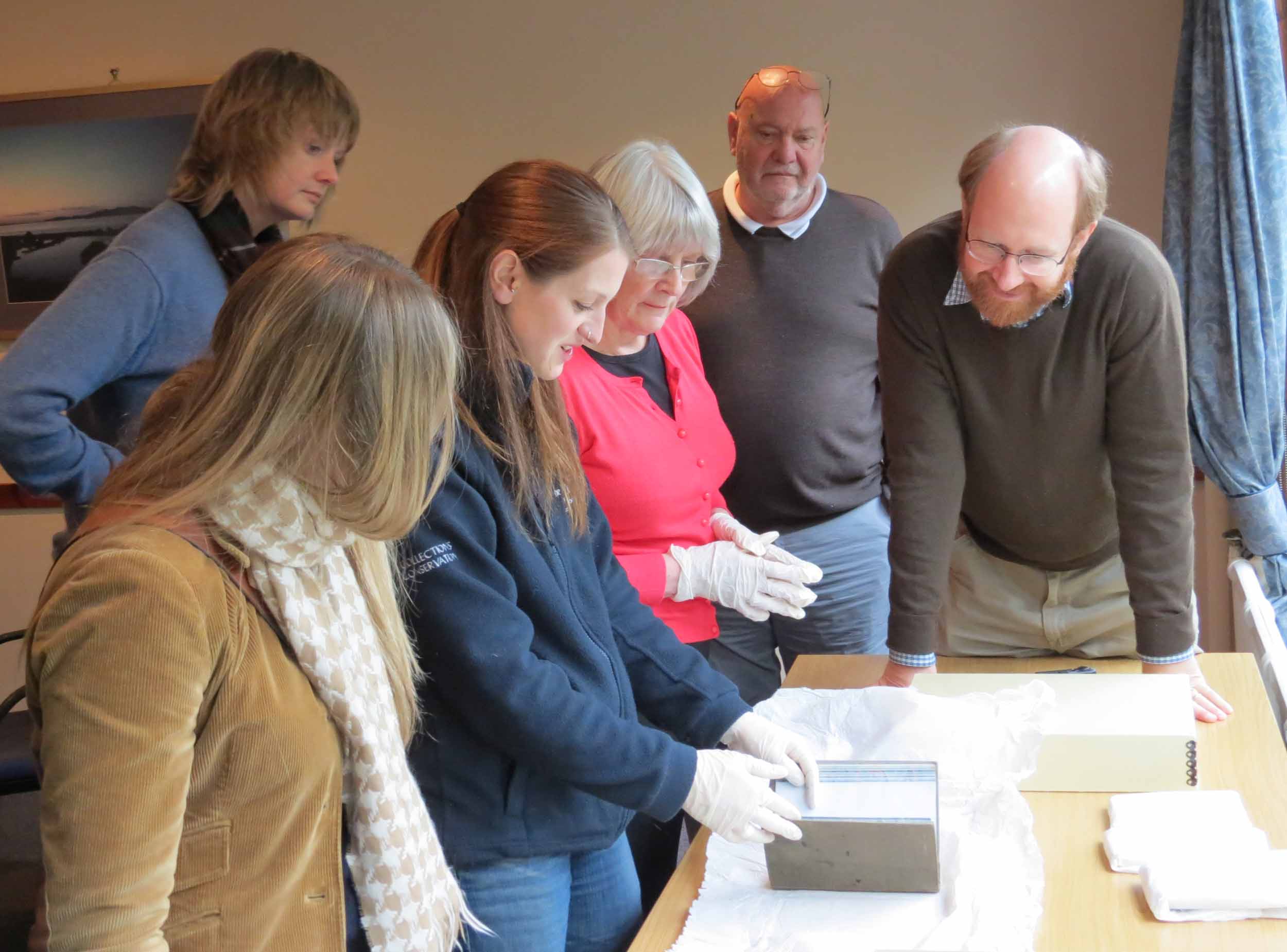
Members of the LEAP team and collaborators view Livingstone manuscripts at the David Livingstone Centre, 2013. Copyright Michael B. Toth. Creative Commons Attribution-NonCommercial 3.0 Unported
This two-part project history discusses each strand of LEAP and includes supporting documentation in the form of photographs and downloadable project documents. Collectively, these materials provide an intimate look into the development of the present site. It is our hope that the materials will serve as a resource for others interested in developing similar digital projects. The provision of these materials also grows out of our project's commitment to methodological transparency. In this spirit, the narrative closes with a summary of some of our principal project challenges and the lessons learned from those challenges.
Prelude to a Grant Top ⤴
The first phase of the Livingstone Spectral Imaging Project (2010-12) and a growing collaboration with Livingstone Online spurred Adrian S. WisnickiAdrian S. Wisnicki (Assistant Professor, University of Nebraska-Lincoln). Director of Livingstone Online, LEAP, and the Livingstone Spectral Imaging Project.'s interest in using advanced imaging technology to study nineteenth-century British manuscripts. While at Indiana University of Pennsylvania, Wisnicki met Megan WardMegan Ward (Assistant Professor, Oregon State University). Co- director of Livingstone Online, LEAP, and the Livingstone Spectral Imaging Project., a Victorianist at Point Park University in Pittsburgh. The two began to discuss a future collaboration on the Livingstone projects and soon settled on applying for an NEH Humanities Collections and Reference Resources Grant (HCRR).
The scale of the HCRR grant would allow for an overhaul and expansion of Livingstone Online, while enabling that project to be integrated with the Livingstone Spectral Imaging Project – thereby creating a comprehensive resource for scholars, scientists, and the public alike. To support this project, Wisnicki brought in a significant number of collaborators from the Spectral Imaging Project and secured the participation of the David Livingstone Centre, the National Library of Scotland, and the UCLA Digital Library.
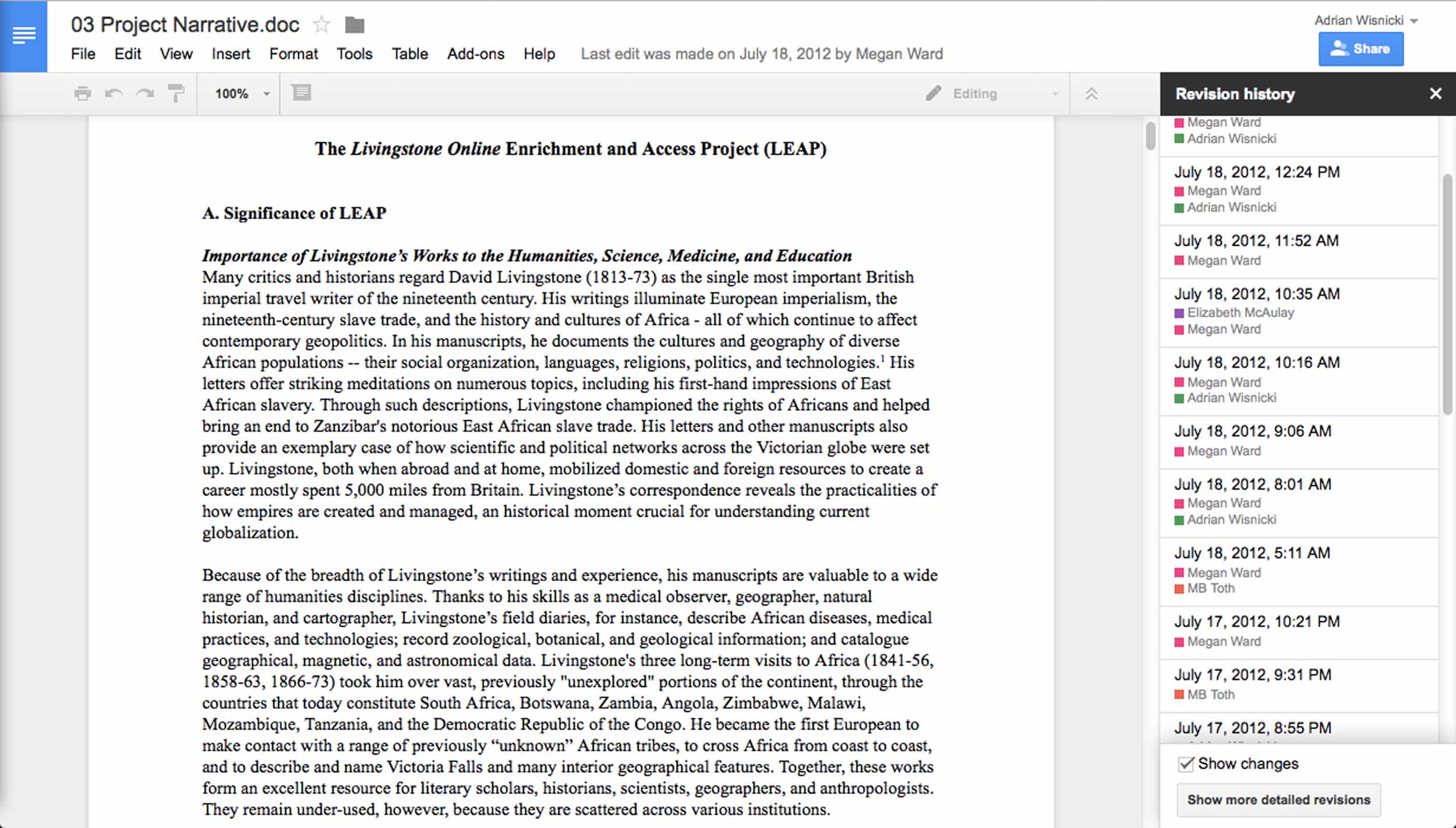
Final draft of the LEAP NEH grant in Google Docs with revision history displayed. Copyright Livingstone Online. Creative Commons Attribution-NonCommercial 3.0 Unported
LEAP: The Livingstone Online Enrichment and Access Project Top ⤴
The newly formed project team settled on "The Livingstone Online Enrichment and Access Project (LEAP)" for the name of their project. They spent the months of May, June, and July 2012 developing the grant. In the application, they set out six principal goals:
1) The redevelopment of the Livingstone Online website to facilitate preservation, access, use, and future scholarship;
2) The integration of all image and transcription data and metadata from Livingstone Online (2005-12) and the Livingstone Spectral Imaging Project (2010-12) to common standards;
3) The addition of new digital materials from the David Livingstone Centre (3,600 manuscript images) and the National Library of Scotland (1,000 manuscript images);
4) A critical, electronic edition of Livingstone's final diaries and journals (1865-1873), possibly the most comprehensive surviving collection of manuscript documents related to any single nineteenth-century British expedition to Africa;
5) An outreach program to take the work of Livingstone Online into the classroom and to produce a digitized teaching resources to be distributed through the site; and
6) Full documentation of all project work.
The team thus set out an ambitious agenda, one that would take Livingstone Online and the Livingstone Spectral Imaging Project, already well-established projects, to new levels.
Download a set of curated NEH Grant Application project documents
Project Launch Top ⤴
On 8 April 2013, WisnickiAdrian S. Wisnicki (Assistant Professor, University of Nebraska-Lincoln). Director of Livingstone Online, LEAP, and the Livingstone Spectral Imaging Project. received the exciting news that the NEH grant application for LEAP had been successful. However, eight months had elapsed between submission of the grant and announcement of the results. During that time, Wisnicki, the director of LEAP, accepted a new position at the University of Nebraska-Lincoln (UNL), one of the leaders for digital humanities research in the US. The NEH award also came with a caveat, a 21% reduction to $275,000 from the original ask of $350,000, with a request that Wisnicki and the project team modify the workplan accordingly.
These developments had four consequences. First, the team scaled back the project to exclude the planned integration of a handful of analytical tools into Livingstone Online. Second, the project team moved the start date from 1 May 2013 to 1 September 2013 to allow for Wisnicki's change of locale. Third, a number of staff from UNL's Center for Digital Research in the Humanities (CDRH) joined the LEAP team to provide local support on the project. Finally, Wisnicki transferred the grant from IUP to UNL, a move not without significant challenges due to the combination of reduced funding and differing F&A rules between IUP and UNL.
Download a set of curated Project Launch project documents
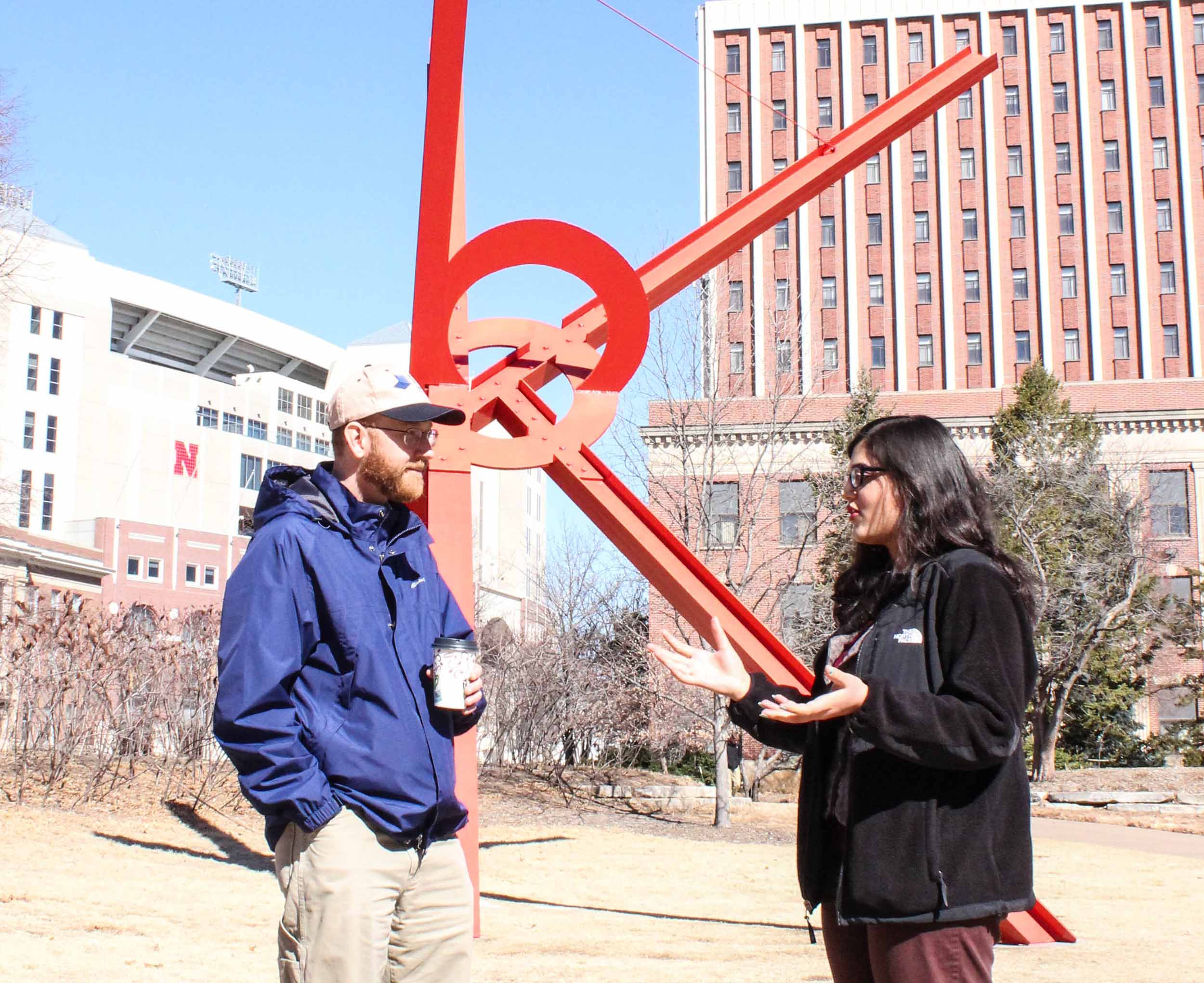
Adrian Wisnicki and Ashanka Kumari on the grounds of the University of Nebraska-Lincoln, 2014. Copyright Angela Aliff. Creative Commons Attribution-NonCommercial 3.0 Unported
LA Kickoff Top ⤴
On 27 September 2013, WisnickiAdrian S. Wisnicki (Assistant Professor, University of Nebraska-Lincoln). Director of Livingstone Online, LEAP, and the Livingstone Spectral Imaging Project. and project manager Michael B. TothMichael B. Toth (President, R.B. Toth Associates). Program manager for LEAP and the Livingstone Spectral Imaging Project. visited the UCLA Digital Library for LEAP's formal kickoff. They met with Digital Library director Stephen DavisonStephen Davison (Director, UCLA Digital Library Program). Institutional co-lead for LEAP., librarian Lisa McAulayLisa McAulay (Librarian, UCLA Digital Library Program). Institutional co-lead for LEAP. and other UCLA staff, as well as the CDRH's Brian Pytlik ZilligBrian Pytlik Zillig (Professor and Digital Initiatives Librarian, Center for Digital Research in the Humanities, University of Nebraska-Lincoln). CDRH co-lead for LEAP., who would lead UNL data management and who joined remotely. The team devoted a good portion of the day to discussing the existing Livingstone data and metadata as well as the new data that would be incoming from the National Library of Scotland and the David Livingstone Centre. Developing and integrating this heterogeneous data would be perhaps the single most complex and difficult task in the project.
Overall project planning also received significant attention. The team reviewed and modified Toth's program plan line by line to ensure it covered all project objectives and that it ordered dependent tasks in logical sequences. The team also decided to hold monthly meetings to track and revise the plan. The periodic reviews would serve not only to flag project tasks that fell behind schedule, but would also identify the downstream impact of such delays. Regular recourse to an NEH compliance matrix, which Toth would soon develop, would also enable the team to track and confirm in detail that it was working to fulfill every promise made in the NEH grant application.
In addition, the LA kickoff gave Wisnicki the chance to meet with the UCLA Digital Library Program staff face-to-face. Incredibly, the opportunity for such an encounter had never arisen during two years of sustained and coordinated work on the Livingstone Spectral Imaging Project. The meeting, everyone agreed, underscored the value of personal contact in projects such as LEAP.
Download a set of curated Planning and LA Kickoff project documents

UCLA Digital Library, 2013. Copyright Livingstone Online. Creative Commons Attribution-NonCommercial 3.0 Unported
UK Kickoff Top ⤴
The LEAP team devoted most of the week of 14 October 2013 to the formal project kickoff in the UK. Since the team had submitted the original grant application over a year ago, the UK kickoff served to reinvigorate the collaborative, transatlantic nature of LEAP and, in some cases, establish new relationships between project team members and staff at supporting institutions.
The itinerary began with a day of meetings at the David Livingstone Centre (near Glasgow), followed by an all-day visit to the University of Glasgow (GU) Photographic Unit where digitization of David Livingstone Centre (DLC) manuscript would occur, and concluded with a series of meetings at the National Library of Scotland in Edinburgh. The week also included a visit to EMMS International in Edinburgh, whose office manager Joe CooneyJoe Cooney (Office Manager, EMMS International). had recently offered to share with Livingstone Online some Livingstone letters in the society’s possession.
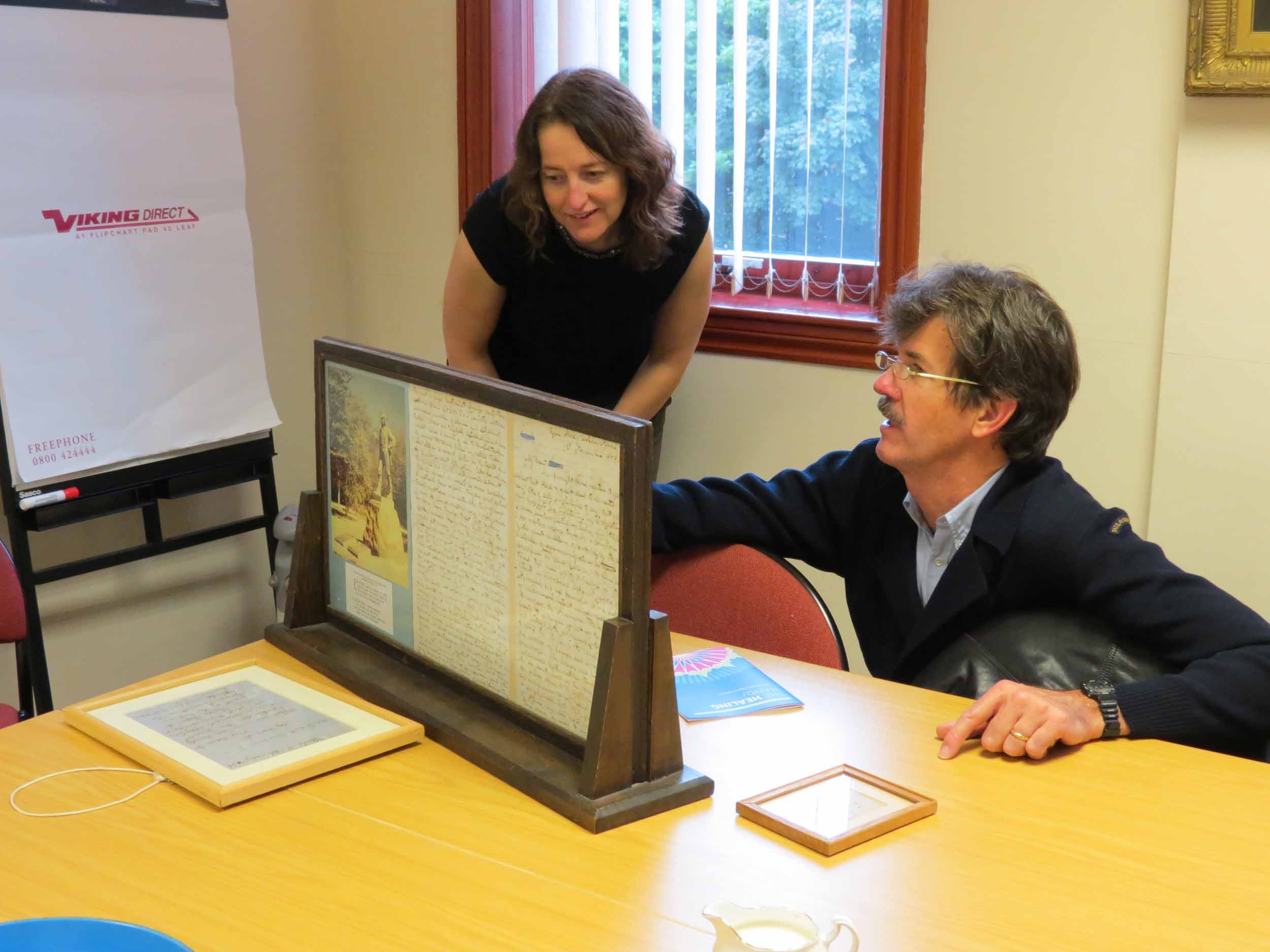
Alison Metcalfe and Mike Toth view a Livingstone manuscript held by EMMS International, 2013. Copyright Michael B. Toth. Creative Commons Attribution-NonCommercial 3.0 Unported
The DLC visit, under the guidance of property managers Karen CarruthersKaren Carruthers (Property Manager, David Livingstone Centre). Institutional contact for Livingstone Online. and Alison RitchieAlison Ritchie (Property Manager, David Livingstone Centre). Institutional contact for Livingstone Online. as well as archivist Anne MartinAnne Martin (Archivist, David Livingstone Centre). Associate director of Livingstone Online., enabled the team to view the Livingstone manuscripts to be digitized in person – the only time most of the members would see these manuscripts during the whole of LEAP – and to discuss the intended outreach program. During the subsequent visit to the GU Photo Unit, the team toured the digitization facilities as well as the GU Special Collections archives where the manuscripts would be held, and the team made plans and defined standards for the subsequent transfer of data and metadata.
The week's last meetings with archivists David McClayDavid McClay (Manuscripts Curator, John Murray Archive, National Library of Scotland). Institutional contact for Livingstone Online. and Alison MetcalfeAlison Metcalfe (Manuscripts Curator, National Library of Scotland). Institutional contact for Livingstone Online. helped to finalize the number of digitized manuscripts that the NLS would provide to Livingstone Online, the intellectual property issues, and metadata used by the NLS. The meetings concluded with the surprise news that the NLS would also be willing to provide Livingstone Online with a trove of images created as part of the NLS bicentenary exhibit "Picturing Africa: Illustrating Livingstone's Travels." This was an exciting development, as the provision of the materials would significantly enhance contextual study of Livingstone's life through the new Livingstone Online site.
Download a set of curated UK Kickoff project documents
Digitizing All Those Livingstone Manuscripts Top ⤴
The LEAP UK kickoff thus resulted in concrete and detailed plans for the delivery of 5,000 manuscript images. Work on digitizing the DLC manuscripts under the guidance of the GU Photographic Unit Manager Stephen McCannStephen McCann (Manager, Photographic Unit, University of Glasgow Library). Lead institutional contact for LEAP. and with the assistance of photographers Jamie DunnJamie Dunn (Digitizer, Photographic Unit, University of Glasgow Library). Digitization specialist for LEAP. and India FullartonIndia Fullarton (Scanner/Digitizer, Photographic Unit, University of Glasgow Library). Digitization specialist for LEAP. was soon underway. A digitization master-list served to coordinate the process. The master-list, based on the original list submitted to the NEH, was expanded with bibliographical data from DLC archivist Anne MartinAnne Martin (Archivist, David Livingstone Centre). Associate director of Livingstone Online. as well as conservator information from Suzanne LambSuzanne Lamb (Conservator, National Trust for Scotland)..
In carrying out the work, GU staff deployed three different digitization systems. For smaller manuscripts (such as field diaries), the staff used an ATIZ book copying system. This allowed the books to be well supported in the Atiz’s unique ‘V’ shaped cradle system and the digitization was conducted using a Digital Single Lens Reflex (DSLR) Canon camera systems. The digitization team at the University of Glasgow also used a copy stand setup with Nikon DSLR camera systems, when they encountered anomalies not suited to the Atiz Bookdrive. The staff turned to a flat copy stand and the use of a Hassleblad 50-megapixel H4D-50MS camera for maps and larger manuscripts such as the Unyanyembe Journal. The Hassleblad captured manuscripts using the 4-shot (Multishot) mode for best resolution and exceptional quality.
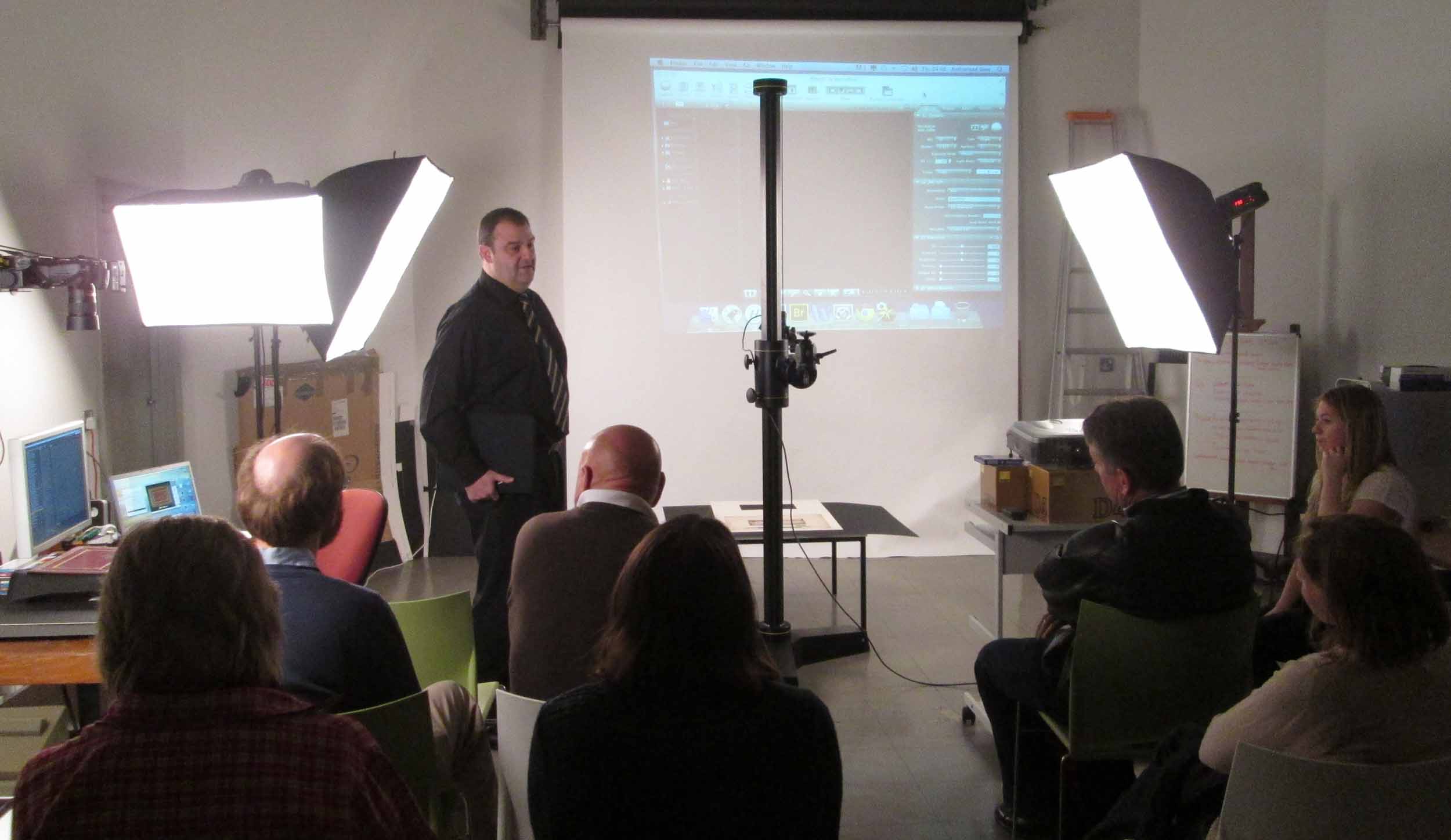
Stephen McCann presents to the LEAP team on the capabilities of the University of Glasgow Photographic Unit, 2013. Copyright Livingstone Online. Creative Commons Attribution-NonCommercial 3.0 Unported
For all items, the GU staff took 16-bit RAW images, which were then converted to 8-bit TIFFs at 600 ppi, color corrected, adjusted and cropped with file naming to LEAP standards done by both automatic and manual methods. The team used Adobe Bridge, Hasselblad’s Phocus, Camera Control Pro, and Exiftool software for their digitization workflow.
GU production of digital images lasted until the end of 2014. Once received in the US via FTP, each image underwent rigorous quality control. WisnickiAdrian S. Wisnicki (Assistant Professor, University of Nebraska-Lincoln). Director of Livingstone Online, LEAP, and the Livingstone Spectral Imaging Project. and WardMegan Ward (Assistant Professor, Oregon State University). Co-director of Livingstone Online, LEAP, and the Livingstone Spectral Imaging Project., in collaboration with Wisnicki's research assistants Ashanka KumariAshanka Kumari (Graduate Student, University of Louisville). Research assistant for Livingstone Online. and Erin CheathamErin Cheatham (Graduate Student, University of Nebraska-Lincoln). Research assistant for Livingstone Online., reviewed all images and delivered the QC results to the Photo Unit for correction and reshooting as required. Corrected images received the same level of QC. Finally, Wisnicki's follow up visit to the UK (fall 2014) served to resolve in-person imaging questions that proved intractable by other means.
Download a set of curated Digitization at the University of Glasgow project documents
Data, Data Everywhere Top ⤴
While UK digitization was ongoing, US-based members of the LEAP team turned to restructuring the legacy data – that is, existing data from previous phases of the project. WisnickiAdrian S. Wisnicki (Assistant Professor, University of Nebraska-Lincoln). Director of Livingstone Online, LEAP, and the Livingstone Spectral Imaging Project. led the work, with significant assistance provided by Ashanka KumariAshanka Kumari (Graduate Student, University of Louisville). Research assistant for Livingstone Online., Michael B. TothMichael B. Toth (President, R.B. Toth Associates). Program manager for LEAP and the Livingstone Spectral Imaging Project., Frank SmutniakFrank Smutniak (Web Developer, Center for Digital Research in the Humanities, University of Nebraska-Lincoln). Web developer for LEAP., Claudia HorningClaudia Horning (Metadata Specialist, UCLA Library). Metadata specialist for LEAP., and Lisa McAulayLisa McAulay (Librarian, UCLA Digital Library Program). Institutional co-lead for LEAP..
 "The Millennium Falcon" (Dell Latitude D630 with custom stand). This computer served as Adrian S. Wisnicki's principal machine on the first phase of the Livingstone Spectral Imaging Project and also did a considerable portion of the work on LEAP. Copyright Angela Aliff. Creative Commons Attribution-NonCommercial 3.0 Unported |
To start, WisnickiAdrian S. Wisnicki (Assistant Professor, University of Nebraska-Lincoln). Director of Livingstone Online, LEAP, and the Livingstone Spectral Imaging Project. and KumariAshanka Kumari (Graduate Student, University of Louisville). Research assistant for Livingstone Online. turned to the most formidable LEAP task: data review. The original Livingstone Online project team (2005-12) had collected image data from a range of institutions. In the interest of long-term digital preservation, the LEAP team decided to use the original, unsorted TIFF manuscript images. This involved examining over 10,000 image files, most of which had little if any documentation. From the fall of 2013 to the spring of 2014, Wisnicki and Kumari sorted and labeled these files, checking and rechecking images against institutional holdings to identify missing, incomplete, or incorrectly identified images.
The process also involved reviewing all existing archival permission agreements. Livingstone Online initially developed during an era when the collaborator permission agreements for digital projects had not yet become standardized or even, in some cases, not used at all. Wisnicki, Chris LawrenceChris Lawrence (professor emeritus, University College London). Former director of Livingstone Online; now director emeritus of the project., and Jared McDonaldJared McDonald (Lecturer, University of the Free State). Associate project scholar and lead contact for South African research for Livingstone Online. now contacted all institutional and individual project collaborators to secure or confirm permission as needed.

The Spacely server, one of LEAP's unsung heroes. This server (now retired) was the principal site for project team file exchange during the main phase of the project's development. Copyright Livingstone Online. Creative Commons Attribution-NonCommercial 3.0 Unported
Then there was the metadata. The original Livingstone Online team had produced some 2,200 MySQL metadata records (e.g., dates, recipients, repository shelfmarks, etc.) for Livingstone's known correspondence as well as 300 records (master IDs, titles, image rights) for illustrative data. The team, under the guidance of UCLA's Claudia HorningClaudia Horning (Metadata Specialist, UCLA Library). Metadata specialist for LEAP., reviewed this metadata and carefully converted it to the MODS format, the project standard determined by the UCLA Digital Library.
Finally, McAulayLisa McAulay (Librarian, UCLA Digital Library Program). Institutional co-lead for LEAP. led UCLA students in cropping legacy image data so as to facilitate and enhance the online display of manuscript images, while SmutniakFrank Smutniak (Web Developer, Center for Digital Research in the Humanities, University of Nebraska-Lincoln). Web developer for LEAP. wrote a series of Groovy, JSON, and Ruby scripts to convert all images and transcriptions to a uniform file naming standard that would be applied across the Livingstone Online digital collection. Smutniak also created scripts to add Dublin Core metadata to all legacy images and, in the interests of facilitating discovery, to generate standalone XMP and TXT metadata files to accompany each image. The overall process of data development lasted nearly a year and a half and would resume in the final phase of LEAP.
Download sets of curated Legacy Data Development, Legacy Data Conversion Scripts, and MODS Development project documents or our Complete MODS Files (3123 files)
Transcriptions Old and New, and to One Standard Top ⤴
Nearly 700 XML-based transcriptions of original manuscripts formed the final piece of legacy data puzzle. The transcriptions had been produced by previous waves of Livingstone Online staff (2005-13) according to a variety of standards. Starting in October 2013, James CummingsJames Cummings (Senior Academic Research Technology Specialist, IT Services, University of Oxford). TEI specialist for Livingstone Online and the Livingstone Spectral Imaging Project. developed a set of encoding guidelines for all Livingstone Online transcriptions – past and future. He offered recommendations on the creation of a TEI ODD (One Document Does-it-all) that would use a schema to ensure that all legacy transcriptions conformed to the LEAP TEI standard and, moreover, would contain LEAP encoding guidelines. Finally, he outlined the way forward for developing the schema and converting transcription files to the agreed standard.
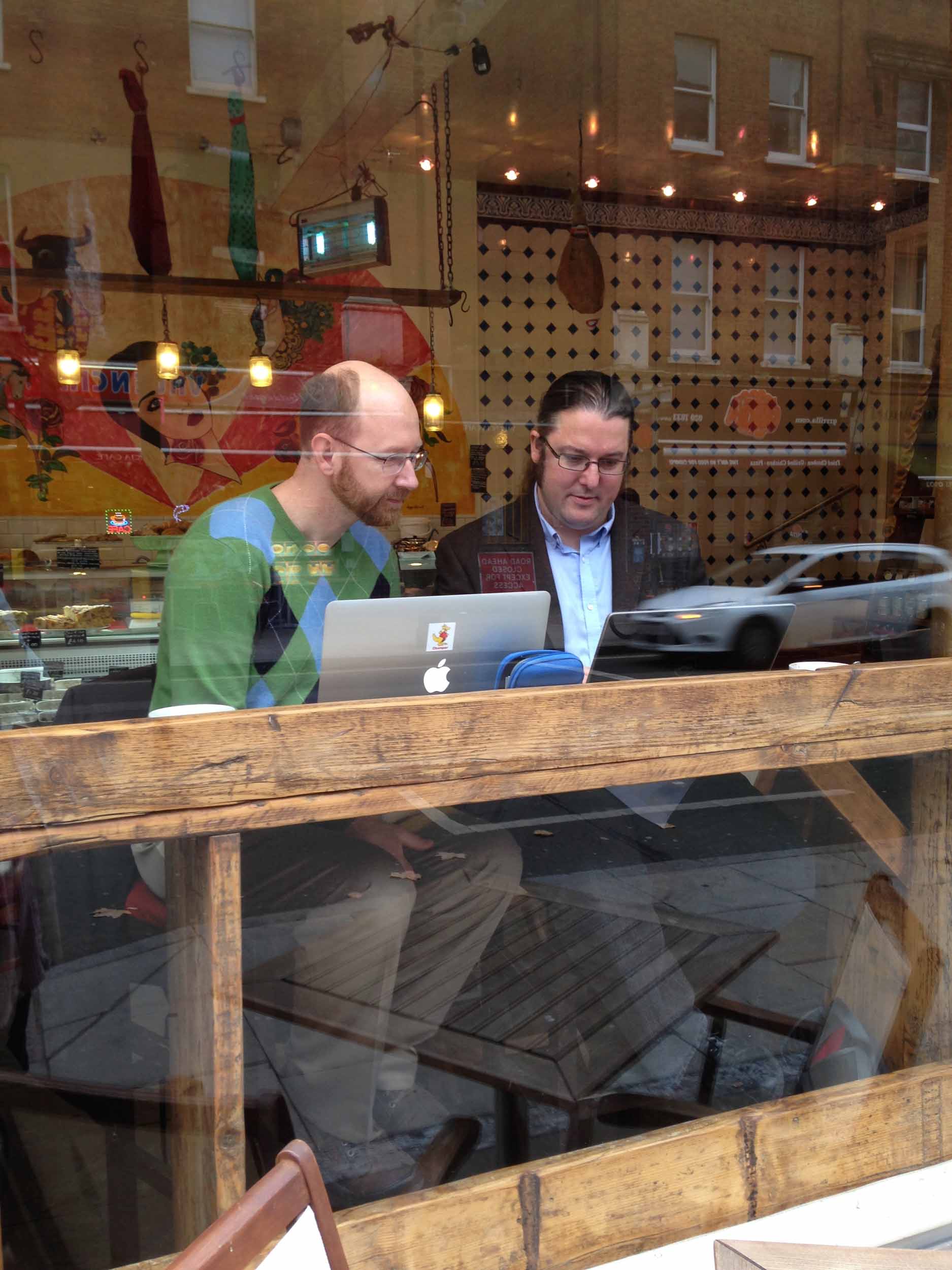 Adrian Wisnicki and James Cummings in London, 2014. Copyright Livingstone Online. Creative Commons Attribution-NonCommercial 3.0 Unported |
By March 2014, the LEAP transcription team was ready to begin its work in transcribing 12 of the surviving 17 of Livingstone's last field diaries (1865-73), the massive Unyanyembe Journal (1866-72), and all of the letters held by the David Livingstone Centre. The transcription team, led by Megan WardMegan Ward (Assistant Professor, Oregon State University). Co-director of Livingstone Online, LEAP, and the Livingstone Spectral Imaging Project. and Heather F. BallHeather F. Ball (Project Cataloger, The Morgan Library & Museum). Coordinating Project Scholar for Livingstone Online., soon came to encompass collaborators from previous phases of Livingstone Online and the Spectral Imaging Project as well as WisnickiAdrian S. Wisnicki (Assistant Professor, University of Nebraska-Lincoln). Director of Livingstone Online, LEAP, and the Livingstone Spectral Imaging Project.'s students from both Indiana University of Pennsylvania and University of Nebraska-Lincoln.
The LEAP Transcription Workflow
1. Initial transcription and encoding (members of core transcription team)
2. Review of transcription and encoding (members of core transcription team)
3. Quality control, standardization, and integration (Heather F. Ball)
4. Encoding review and resolution (Adrian S. Wisnicki)
5. Final text-only proofing (Chris LawrenceChris Lawrence (professor emeritus, University College London). Former director of Livingstone Online; now director emeritus of the project.)
6. Final overall review (Adrian S. Wisnicki)
7. Review of extracted word lists (Heather F. Ball)
Each transcription underwent seven stages of production, review, and quality control. A Google Drive-based project workflow coordinated the team efforts and streamlined scheduling, while recourse to the Spacely server at the University of Nebraska-Lincoln facilitated the exchange of transcription files among team members. As transcription practices evolved, Wisnicki and Ball updated the encoding manual and worked closely with LEAP team members to address, resolve, and track all encoding issues. A year and a half after starting, the LEAP transcription team had thus successfully transcribed and encoded nearly all of the final field diaries, some 350 (of 700 pages) of the Unyanyembe Journal, and all of the DLC letters.
Download sets of curated TEI Transcription Conversion and TEI Transcription Encoding project documents or our Complete TEI Files (792 Files)
The New, Improved, and Expanded Core Digital Collection Top ⤴
Ultimately, the work of recovering the Livingstone Online image and transcription data and metadata proved to be a major LEAP accomplishment, as detailed in the preliminary and interim data reports. The LEAP team correlated all legacy images and transcriptions, produced MODS metadata records for all of Livingstone's known correspondence as well as a variety of additional items, and, most importantly, identified images for some 300 items that the Livingstone Online team had collected, but not processed, in the project's initial phases.
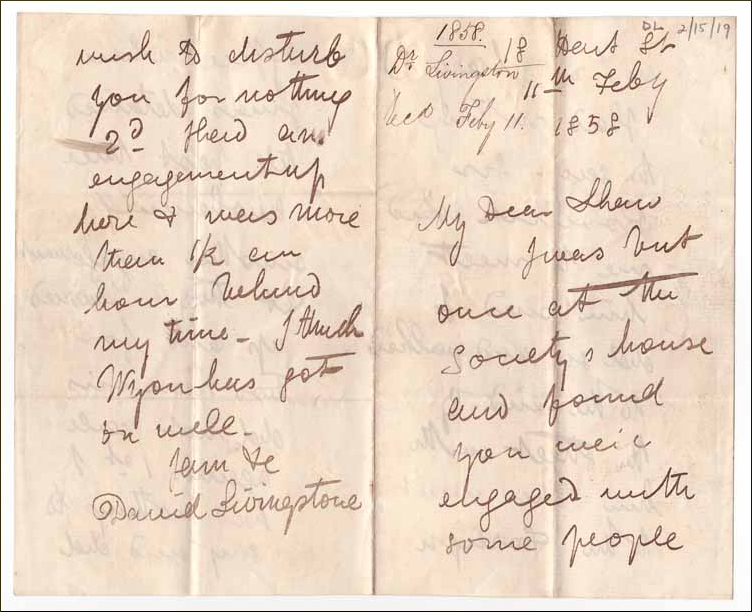
Letter to H. Norton Shaw, 11 February 1858, by David Livingstone. Image copyright Royal Geographical Society (with IBG). Used by permission for academic purposes only. For non-academic use permission, please contact the Picture Library. Text (as relevant) copyright Dr. Neil Imray Livingstone Wilson: Creative Commons Attribution-NonCommercial 3.0 Unported
Moreover, the data work enabled the LEAP team to reestablish links with archival institutions such as the Royal Geographical Society and SOAS, University of London, both of which provided dozens of manuscript images, free of charge, to fill out the Livingstone Online digital image collection. Additionally, through extensive metadata review as well as by ransacking online auction records, WisnickiAdrian S. Wisnicki (Assistant Professor, University of Nebraska-Lincoln). Director of Livingstone Online, LEAP, and the Livingstone Spectral Imaging Project. was able to correct and update an array of existing metadata records details, create some 150 new MODS records for items incoming from the DLC and NLS, and catalogue details of numerous Livingstone items auctioned during the last decade.
The collective result of these efforts meant that the new Livingstone Online would enhance the study of Livingstone and his life and times through the provision of a broadly expanded collection of items, while providing more information about these items than ever before.
Download a set of curated Documenting the Core Digital Collection project documents
Imagining the New Livingstone Online Top ⤴
In addition to development of core data, LEAP empowered the project team to overhaul the Livingstone Online site top to bottom. This involved, first, converting the site to Islandora, an open-source software framework combining Drupal for its front end and Fedora for its back end, and, second, redesigning the interface to cater to modern user sensibilities and expectations. The first element would allow the site to be integrated into the UCLA Digital Library collections and so be maintained and preserved long-term as part of those collections (as was then anticipated). The second would hopefully facilitate access to the site's materials by a variety of users.
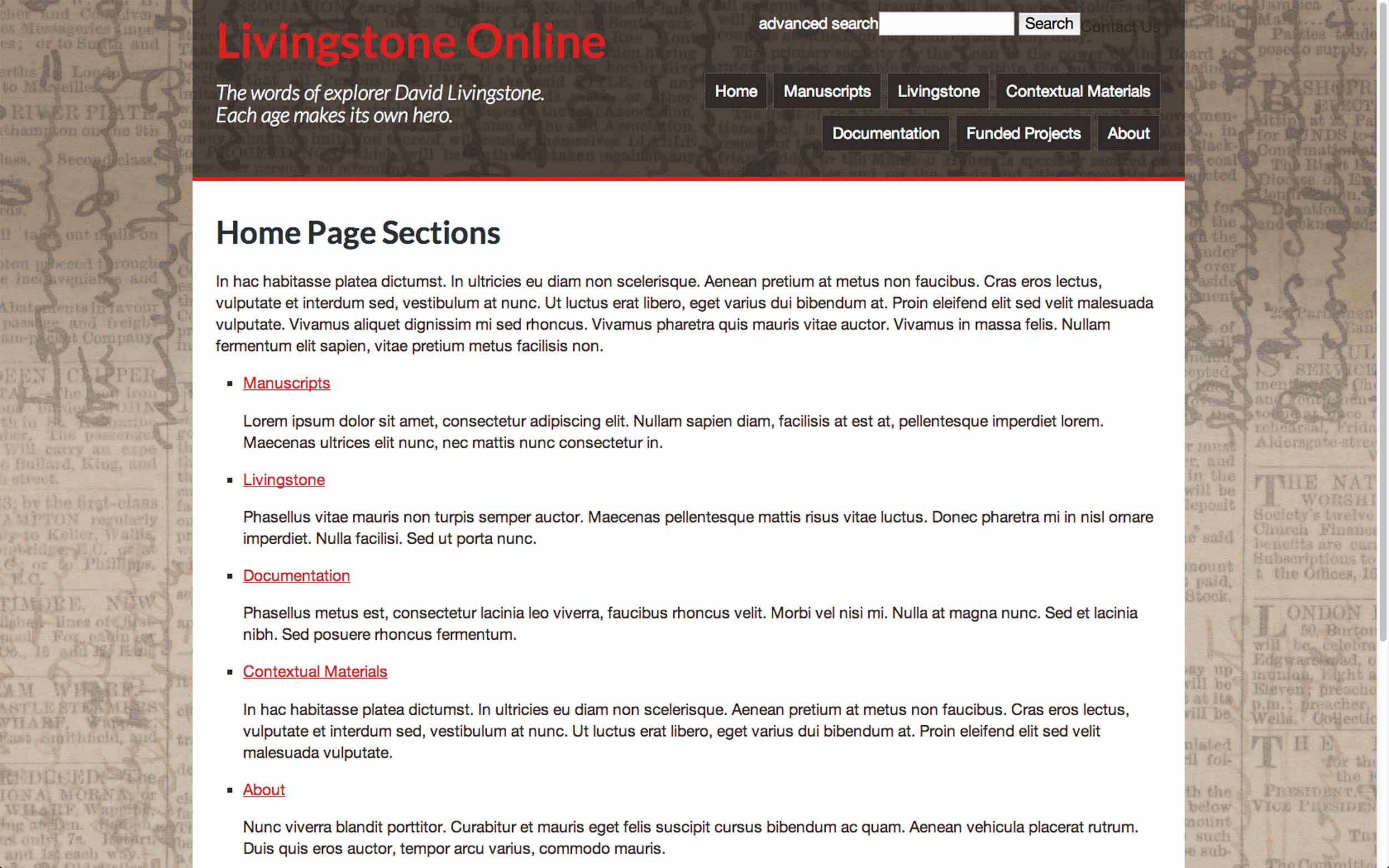
An early design mockup for the new Livingstone Online, 2013. Copyright Karin Dalziel. Creative Commons Attribution-NonCommercial 3.0 Unported
WisnickiAdrian S. Wisnicki (Assistant Professor, University of Nebraska-Lincoln). Director of Livingstone Online, LEAP, and the Livingstone Spectral Imaging Project. had begun a preliminary conversion of the site to Drupal while still at Indiana University of Pennsylvania (and prior to LEAP), with student programmers Adam ColtonAdam Colton (Graduate Student, Indiana University of Pennsylvania). Web developer for Livingstone Online., Annie LinAnnie Lin (Undergraduate Student, Indiana University of Pennsylvania). Web developer for Livingstone Online., and Eliza AlbertEliza Albert (Graduate Student, Indiana University of Pennsylvania). Web developer for Livingstone Online.. Once LEAP began, Wisnicki brought the Drupal site files to UNL, where Karin DalzielKarin Dalziel (Digital Designer and Development Specialist, Center for Digital Research in the Humanities, University of Nebraska-Lincoln). CDRH co-lead for LEAP. set about enhancing the conversion and beginning the work of redesigning the site's aesthetic dimension. When the Drupal site files went over to UCLA in early 2014, Wisnicki convened a sub-group of project team members (himself, WardMegan Ward (Assistant Professor, Oregon State University). Co-director of Livingstone Online, LEAP, and the Livingstone Spectral Imaging Project., and students Angela AliffAngela Aliff (Graduate Student, Indiana University of Pennsylvania). Research assistant and interface designer for Livingstone Online., Ashanka KumariAshanka Kumari (Graduate Student, University of Louisville). Research assistant for Livingstone Online., and Erin CheathamErin Cheatham (Graduate Student, University of Nebraska-Lincoln). Research assistant for Livingstone Online.) to focus on site redesign. The subgroup soon became known as the LEAP Aesthetic Action Team.
Site Levels for the New Livingstone Online
Home page (Level 1) - Links to section pages
Section Pages (Level 2) - Six, each with links to content pages
Secondary Content Pages (Level 3) - Critical essays and similar materials
Primary Content Pages (Level 4) - Images, transcriptions, metadata for Livingstone manuscripts
Secondary Content Page Variants (Level 5) - Browse and search options for manuscripts
Given the broad audience of Livingstone Online, the team envisioned a site for a range of users and drew inspiration from a variety of model sites (e.g., The New York Times, Apple, CAST83), not just other academic websites. Led by Wisnicki and Aliff, a new site began to emerge, with more images, vibrant colors, and visually-guided navigation. A series of detailed mockups laid out the specifications for this new site.
Download sets of curated The New Livingstone Online - Site Development at UNL and The New Livingstone Online - Site Mockups project documents
(Re)defining Livingstone Online's Vision Top ⤴
The new Livingstone Online would also feature numerous critical and historical essays. During the first year of LEAP, therefore, WisnickiAdrian S. Wisnicki (Assistant Professor, University of Nebraska-Lincoln). Director of Livingstone Online, LEAP, and the Livingstone Spectral Imaging Project. and WardMegan Ward (Assistant Professor, Oregon State University). Co-director of Livingstone Online, LEAP, and the Livingstone Spectral Imaging Project. reviewed and edited all legacy critical materials with an eye to incorporating and so preserving them in the new site, while also making them readable on mobile devices.
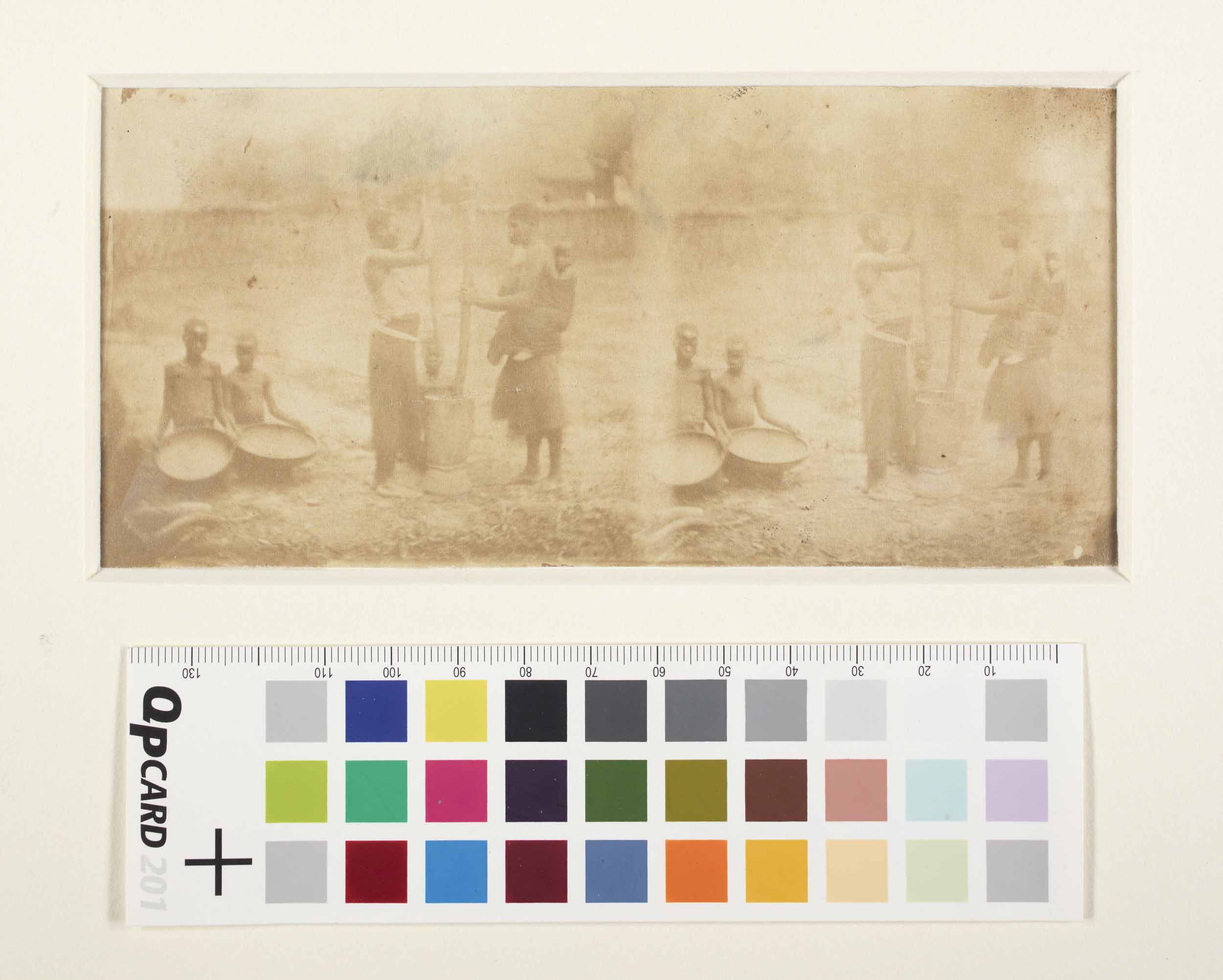
Photographic Scene in an African Village, c.1857-1865, by Charles Livingstone. Copyright National Library of Scotland. Creative Commons Share-alike 2.5 UK: Scotland
One of the key goals was to foster an awareness of Livingstone's complex and often controversial legacy. To help articulate this, Joanne IchimuraJoanne Ichimura (Archivist, Special Collections, SOAS Library, University of London). Institutional contact for Livingstone Online., Justin LivingstoneJustin Livingstone (Research Fellow, Queen’s University Belfast). Associate project scholar for Livingstone Online., and Jared McDonaldJared McDonald (Lecturer, University of the Free State). Associate project scholar and lead contact for South African research for Livingstone Online. kindly shared versions of materials related to the 2013 bicentenary exhibit at SOAS, University of London. The inclusion of these materials on the new Livingstone Online would play an important role in WisnickiAdrian S. Wisnicki (Assistant Professor, University of Nebraska-Lincoln). Director of Livingstone Online, LEAP, and the Livingstone Spectral Imaging Project. and WardMegan Ward (Assistant Professor, Oregon State University). Co-director of Livingstone Online, LEAP, and the Livingstone Spectral Imaging Project.'s efforts to avoid perpetuating colonialist modes of representing Livingstone's legacy and the non-Western regions he visited.
As part of the legacy essay review, KumariAshanka Kumari (Graduate Student, University of Louisville). Research assistant for Livingstone Online. also worked with Wisnicki and original Livingstone Online team members to draft a history of the project for the years 2004-13. Finally, Wisnicki and Ward, with assistance from Kumari, also expanded and updated the Livingstone Online bibliography to encompass a variety of primary, secondary, and tertiary materials. They then created a custom Zotero library of these materials in order to facilitate collaborative development, while enabling future export of this bibliographic data in a variety of formats, such as TEI, MODS, and RDF.
Download a set of curated Critical Materials and Permissions project documents
Getting the Word Out: Scholars, Stakeholders, and Social Media Top ⤴
As all project facets developed, the LEAP team took steps to inform scholars, stakeholders, and general users of project progress. During the first year of LEAP, team members spoke about the project at the Smithsonian, the National Endowment for the Humanities, the University of Glasgow, Temple University, the Chicago Colloquium on Digital Humanities and Computer Science (DePaul University), the Text Encoding Initiative (TEI) 2014 conference in Chicago, and the University of Nebraska-Lincoln's Digital Humanities Faculty Fellows Forum.
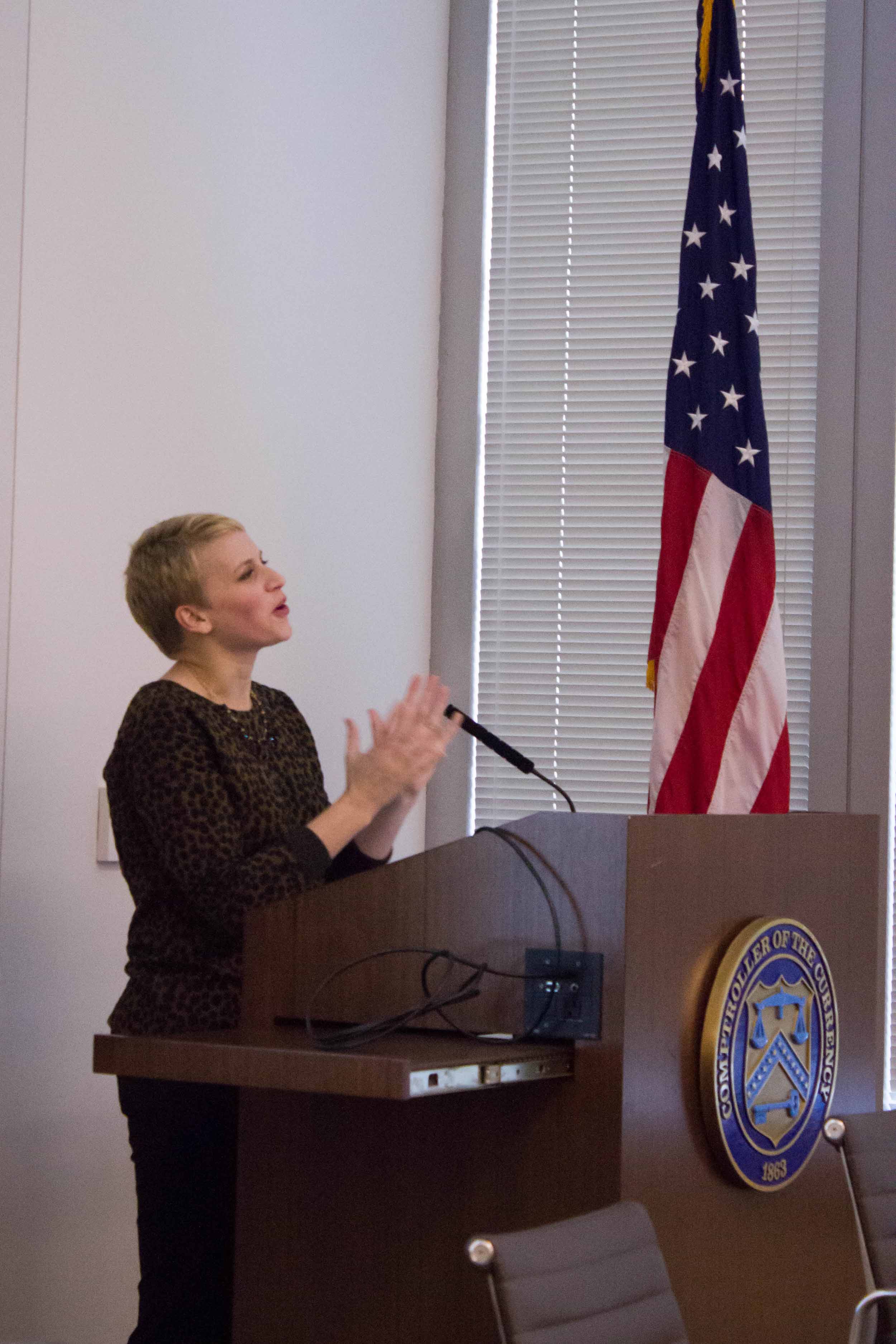 Angela Aliff lectures at the National Endowment for the Humanities, 2014 Copyright Angela Aliff. Creative Commons Attribution-NonCommercial 3.0 Unported |
In November 2014, slightly more than a year from the project's beginning, WisnickiAdrian S. Wisnicki (Assistant Professor, University of Nebraska-Lincoln). Director of Livingstone Online, LEAP, and the Livingstone Spectral Imaging Project. arranged a series of meetings in Scotland and England, during which he delivered project updates to representatives of the David Livingstone Centre, National Library of Scotland, University College London, SOAS, University of London, and the Universities of Edinburgh, Glasgow, and Oxford. These meetings included a visit with Neil Imray Livingstone WilsonNeil Imray Livingstone Wilson. Great great grandson of David Livingstone. (great great grandson of David Livingstone), whose family had been strong supporters of Livingstone Online since the inception of the project in 2004.
The LEAP team also began to reach out to new audiences through the newly created Wordpress blog and Twitter account. Regular tweets covered all aspects of the project while a range of blog posts sought to define the Livingstone Online site, its goals, and its content for a broad audience.
Download a set of curated Dissemination - Scholars, Stakeholders, Social Media project documents
Getting the Word Out: Into Schools Top ⤴
LEAP's outreach program comprised the final element of the dissemination work, led jointly by LEAP team members (Kate SimpsonKate Simpson (Graduate Student, Edinburgh Napier University). Project scholar and UK outreach coordinator for Livingstone Online., Megan WardMegan Ward (Assistant Professor, Oregon State University). Co-director of Livingstone Online, LEAP, and the Livingstone Spectral Imaging Project.), staff of the David Livingstone Centre (Martha B. FindlayMartha B. Findlay (Learning Officer, David Livingstone Centre)., Alison RitchieAlison Ritchie (Property Manager, David Livingstone Centre). Institutional contact for Livingstone Online.), and schools local to the David Livingstone Centre in Blantyre. In the fall of 2013, Simpson and Findlay began work on this program with a "pre-pilot" that encouraged local school children to interact with Livingstone's 1871 Field Diary.
Based on the experience of the pre-pilot, Ward and Simpson developed a series of worksheets that would encourage students to explore relevant historical themes (e.g., slavery, global citizenship, African culture) through Livingstone Online. In this they were assisted by volunteer Alastair SimpsonAlastair Simpson (Volunteer, David Livingstone Centre). who provided worksheet design and layout support.
The worksheets were tested at the DLC with school groups and revised with the goal of making them freely available via Livingstone Online. In addition, Simpson also reached out to Lynne RobertsonLynne Robertson (Senior Education Officer, Education Scotland) at Education Scotland, a Scottish governmental body responsible for supporting teaching and learning. Robertson agreed to link to and endorse the Livingstone Online worksheets. With work on the pilot complete, Ward and Samantha FitchSamantha Fitch (Graduate Student, Indiana University of Pennsylvania). Research assistant for Livingstone Online., another member of the LEAP team, then took the first steps towards designing a US version of the outreach program.
Download a set of curated Dissemination - Outreach for Schools project documents
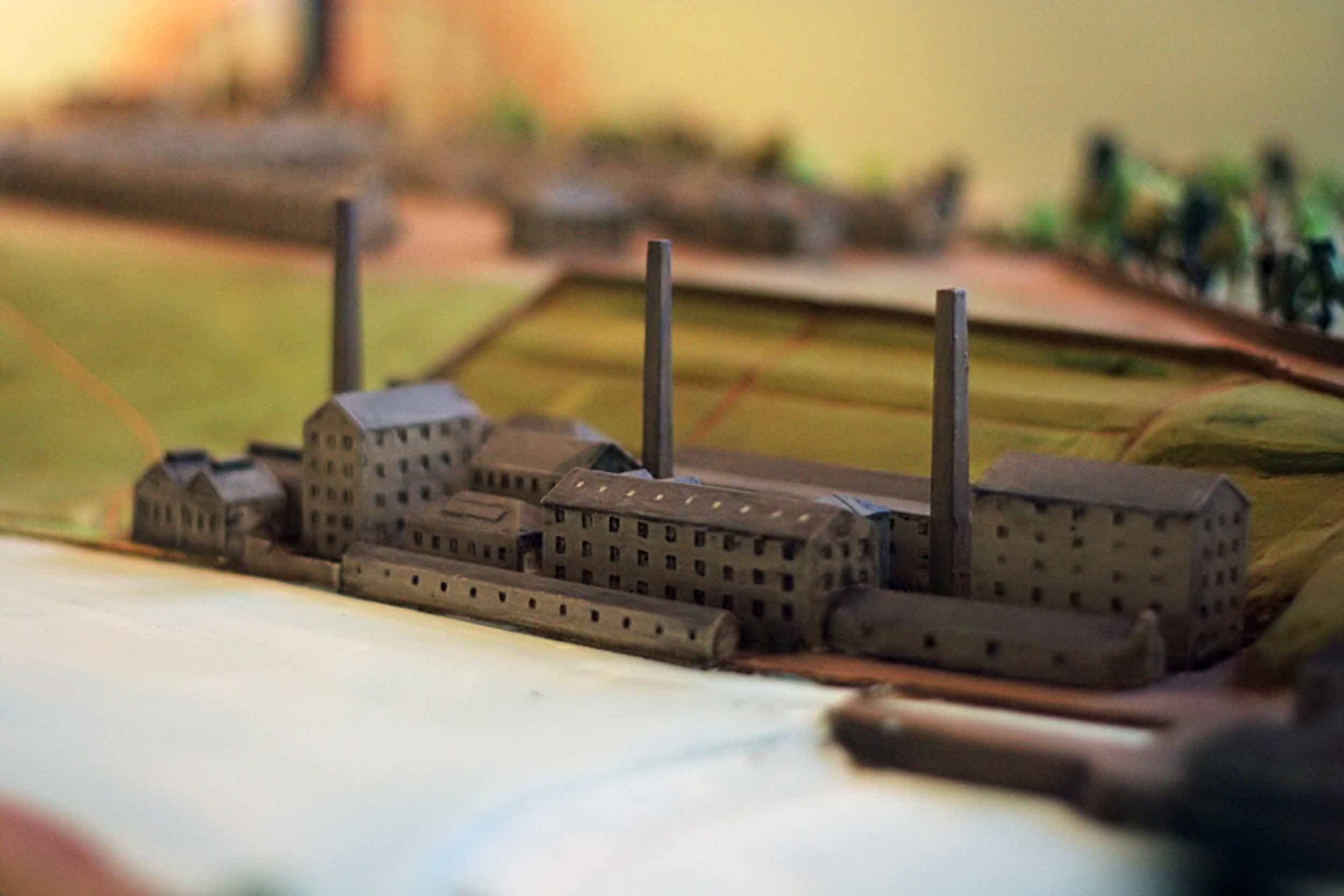
Model of the Blantyre Mills, detail, by Pilkington Jackson. Livingstone worked in these mills as a boy. Copyright Livingstone Online. May not be reproduced without the express written consent of the National Trust for Scotland, on behalf of the Scottish National Memorial to David Livingstone Trust (David Livingstone Centre).
The Website Emerges Top ⤴
Website implementation was the last step in the 1.5-year arc of development that drew on the concentrated efforts of LEAP's project team. WisnickiAdrian S. Wisnicki (Assistant Professor, University of Nebraska-Lincoln). Director of Livingstone Online, LEAP, and the Livingstone Spectral Imaging Project., with guidance from TothMichael B. Toth (President, R.B. Toth Associates). Program manager for LEAP and the Livingstone Spectral Imaging Project., interfaced with McAulayLisa McAulay (Librarian, UCLA Digital Library Program). Institutional co-lead for LEAP. and DavisonStephen Davison (Director, UCLA Digital Library Program). Institutional co-lead for LEAP. to direct this aspect of LEAP. In a separate process, Wisnicki also worked directly with James CummingsJames Cummings (Senior Academic Research Technology Specialist, IT Services, University of Oxford). TEI specialist for Livingstone Online and the Livingstone Spectral Imaging Project. on XSLT to display the legacy transcriptions.
In the initial stages of site development, UCLA Digital Library staff sought to distinguish and define the digital assets to be added to both the Drupal front end and Fedora back end of the new Livingstone Online site. With a rough enumeration complete, the team then turned to planning the development and implementation of the site. Site development consisted of four stages: initial work done on individual developer machines, the transfer and testing of code on a "dev" site available only to UCLA staff, then on to "stage" where the LEAP project team first began to review completed work, and, finally, to "production," i.e. the public version of the website.
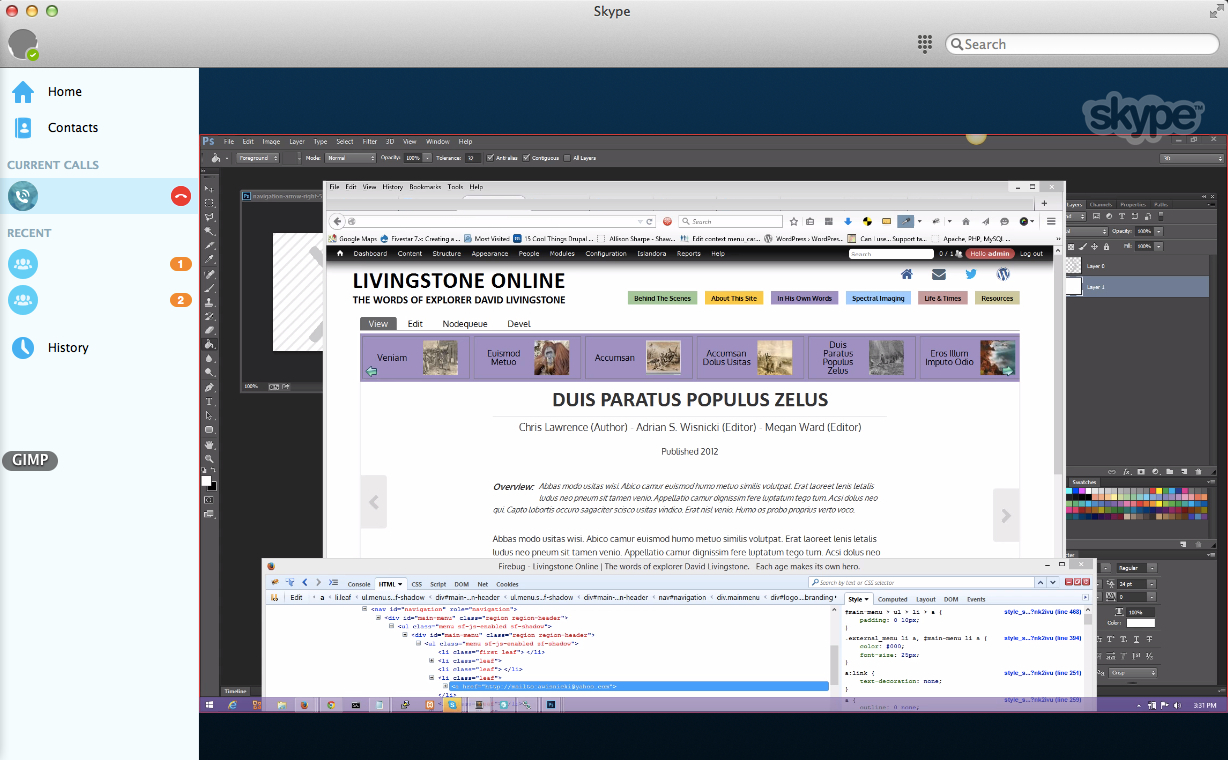
Screenshot of Kathy Chavez's desktop as she and Adrian Wisnicki collaborate on site development via Skype. Copyright Livingstone Online. Creative Commons Attribution-NonCommercial 3.0 Unported
In early 2015, Wisnicki and Davison set target dates of mid spring for the internal alpha release of the site and early summer for the public beta site release. A final shift in workflow accompanied this last phase of development. To enable UCLA to work to its strength of back-end development, Kathy ChavezKathy Chavez (Web Developer, KappaLuppa, Inc.). Web developer for LEAP. of KappaLuppa, Inc. joined the project team to collaborate directly with Wisnicki on refinement of the Drupal interface, while UCLA set out an internal project plan to ensure the timely delivery of the alpha release....
Download sets of curated The New Livingstone Online - Site Development at UCLA, The New Livingstone Online - Site Development: XSLT, and Archival Image Download Documentation project documents













